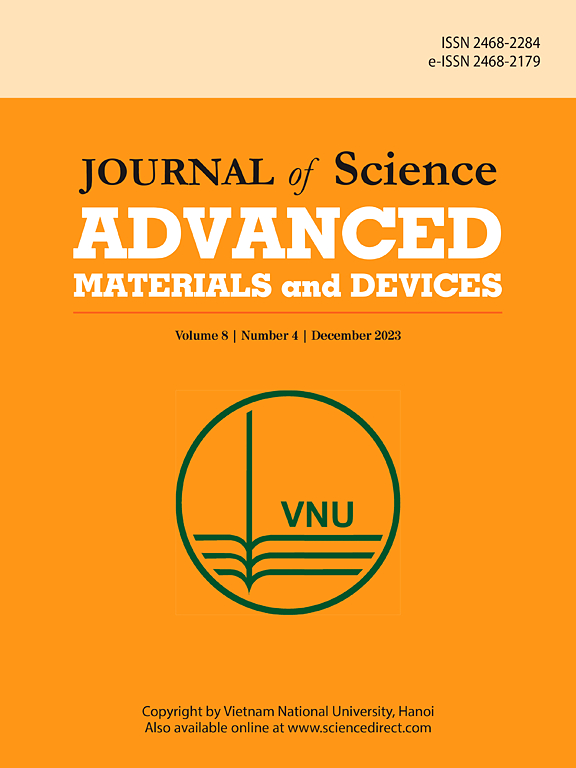增强伤口愈合与亚麻籽提取物负载聚乙烯醇纳米纤维支架:植物化学成分,抗氧化活性和抗菌性能
IF 6.7
3区 材料科学
Q1 MATERIALS SCIENCE, MULTIDISCIPLINARY
Journal of Science: Advanced Materials and Devices
Pub Date : 2025-02-08
DOI:10.1016/j.jsamd.2025.100862
引用次数: 0
摘要
本研究旨在开发和优化复合纳米纤维支架,以增强伤口愈合和抗菌应用。采用溶液静电纺丝法制备了负载亚麻籽提取物的聚乙烯醇(PVA)纳米纤维。该方法侧重于优化关键参数,包括聚合物与提取物比、溶胀比、水解降解和纳米纤维平均直径,以获得优越的支架性能。优化后的支架,PVA与亚麻籽提取物的重量比为70:30 (PV70:FS30),具有无珠形态,平均纤维直径为319 nm(纯PVA纤维为175 nm)。PV70:FS30支架具有显著的抗菌活性,可有效抑制革兰氏阴性和革兰氏阳性细菌的生长。此外,PV70:FS30支架上的人黑素细胞(HBF-4)活力和伤口愈合率明显高于纯PVA纤维(活力:122.3% vs. 91.2%;48小时伤口关闭:97.3% vs. 69.6%(相对于对照组)。然而,PV70:FS30支架上的细胞粘附较低(93个细胞/切片,而PVA纳米纤维为183个细胞/切片),这是由于加入亚麻籽提取物增加了交联,降低了亲水性。这些发现表明亚麻籽提取物浓度与支架形态之间存在明显的相互作用,突出了它们在推进皮肤组织工程应用方面的潜力。这些结果为设计纳米纤维支架以改善伤口愈合和抗菌性能提供了见解。本文章由计算机程序翻译,如有差异,请以英文原文为准。

Enhanced wound healing with flaxseed extract-loaded polyvinyl alcohol nanofibrous scaffolds: Phytochemical composition, antioxidant activity, and antimicrobial properties
This study aimed to develop and optimize composite nanofibrous scaffolds for enhanced wound healing and antimicrobial applications. Polyvinyl alcohol (PVA) nanofibers loaded with ethanolic flaxseed extract were fabricated via solution electrospinning. The methodology focused on optimizing key parameters, including polymer-to-extract ratio, swelling ratio, hydrolytic degradation, and nanofiber mean diameter, to achieve superior scaffold properties. The optimized scaffold, with a PVA-to-flaxseed extract weight ratio of 70:30 (PV70:FS30), exhibited bead-free morphology and a mean fiber diameter of 319 nm (compared to 175 nm for pure PVA fibers). PV70:FS30 scaffolds demonstrated significant antimicrobial activity, effectively inhibiting both Gram-negative and Gram-positive bacterial growth. Moreover, human melanocyte (HBF-4) viability and wound healing rates were substantially higher on PV70:FS30 scaffolds than on pure PVA fibers (viability: 122.3% vs. 91.2%; wound closure at 48 h: 97.3% vs. 69.6%, relative to control). However, cell adhesion was lower on PV70:FS30 scaffolds (93 cells/section vs. 183 cells/section for PVA nanofibers) due to increased cross-linking and reduced hydrophilicity from flaxseed extract incorporation. These findings indicate a clear interplay between flaxseed extract concentration and scaffold morphology, highlighting their potential for advancing skin tissue engineering applications. These results provide insights into designing nanofibrous scaffolds for improved wound healing and antimicrobial properties.
求助全文
通过发布文献求助,成功后即可免费获取论文全文。
去求助
来源期刊

Journal of Science: Advanced Materials and Devices
Materials Science-Electronic, Optical and Magnetic Materials
CiteScore
11.90
自引率
2.50%
发文量
88
审稿时长
47 days
期刊介绍:
In 1985, the Journal of Science was founded as a platform for publishing national and international research papers across various disciplines, including natural sciences, technology, social sciences, and humanities. Over the years, the journal has experienced remarkable growth in terms of quality, size, and scope. Today, it encompasses a diverse range of publications dedicated to academic research.
Considering the rapid expansion of materials science, we are pleased to introduce the Journal of Science: Advanced Materials and Devices. This new addition to our journal series offers researchers an exciting opportunity to publish their work on all aspects of materials science and technology within the esteemed Journal of Science.
With this development, we aim to revolutionize the way research in materials science is expressed and organized, further strengthening our commitment to promoting outstanding research across various scientific and technological fields.
 求助内容:
求助内容: 应助结果提醒方式:
应助结果提醒方式:


